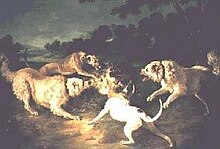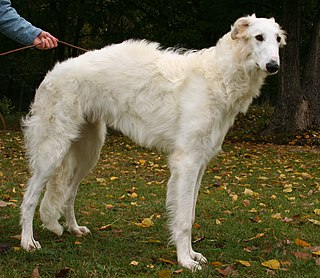
The Borzoi or Russian Hunting Sighthound is a Russian breed of hunting dog of sighthound type. It was formerly used for wolf hunting, and until 1936 was known as the Russian Wolfhound.
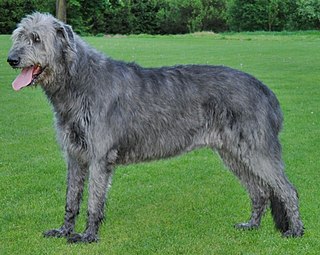
The Irish Wolfhound is a breed of large sighthound that has, by its presence and substantial size, inspired literature, poetry and mythology. Strongly associated with Gaelic Ireland and Irish history, they were famed as guardian dogs and for hunting wolves.
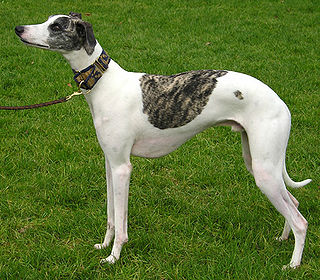
Sighthounds, also called gazehounds, are a type of dog, hounds that hunt primarily by sight and speed rather than by scent and endurance as scent hounds do.

The Scottish Deerhound, or simply the Deerhound, is a large breed of sighthound, once bred to hunt the red deer by coursing. In outward appearance, the Scottish Deerhound is similar to the Greyhound, but larger and more heavily boned with a rough-coat.

A hound is a type of hunting dog used by hunters to track or chase prey.

Scent hounds are a type of hound that primarily hunts by scent rather than sight. These breeds are hunting dogs and are generally regarded as having some of the most sensitive noses among dogs. Scent hounds specialize in following scent or smells. Most of them tend to have long, drooping ears and large nasal cavities to enhance smell sensitivity. They need to have relatively high endurance to be able to keep track of scent over long distances and rough terrain. It is believed that they were first bred by the Celts by crossbreeding mastiff-type dogs with sighthounds. The first established scent hounds were St. Hubert Hounds bred by monks in Belgium during the Middle Ages.
Lure coursing is a sport for dogs that involves chasing a mechanically operated lure. Competition is typically limited to dogs of purebred sighthound breeds. The AKC has a pass/fail trial for all breeds called the Coursing Ability Test (CAT) and a timed 100 yard dash called Fast CAT where the dog's speed is converted to points.

The Otterhound is a British dog breed. It is a scent hound and is currently recognised by the Kennel Club as a Vulnerable Native Breed with around 600 animals worldwide.
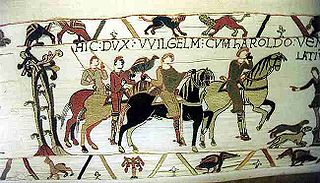
Royal hunting, also royal art of hunting, was a hunting practice of the of the aristocracy throughout the known world in the Middle Ages, from Europe to Far East. While humans hunted wild animals since time immemorial, and all classes engaged in hunting as an important source of food and at times the principal source of nutrition. The necessity of hunting was transformed into a stylized pastime of the aristocracy. More than a pastime, it was an important arena for social interaction, essential training for war, and a privilege and measurement of nobility. In Europe in the High Middle Ages the practice was widespread.
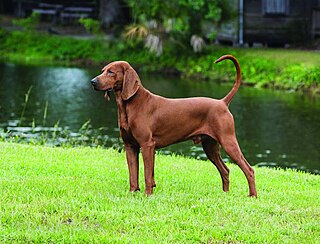
The Redbone Coonhound is an American breed of hunting dog. The Redbone is a courageous hunter often used to track large game such as bear, boar, cougar, though it is also used to track smaller game such as deer. The breed dates back to pre-Civil War and is one of the most versatile of all the hounds. It originated in the Southern United States, and its foundation stock derives from bloodhounds and foxhounds brought by immigrants from Scotland. It is characterized by its deep red coat.

The Segugio Italiano is either of two Italian breeds of dog of scent hound type, the wire-haired Segugio Italiano a Pelo Forte or the short-haired Segugio Italiano a Pelo Raso. Apart from the coat type, they are closely similar, and in some sources may be treated as a single breed; the Fédération Cynologique Internationale and the Ente Nazionale della Cinofilia Italiana treat them as separate. They are also genetically close to the other two Italian scent hound breeds, the Segugio Maremmano and the Segugio dell'Appennino. They are traditionally used for hunting hare, but may also be used in boar hunts.

The kangaroo dog or kangaroo hound is an Australian type of sighthound purposely crossbred from a variety of sighthound breeds to produce a hunting dog.

Hunting in Russia has an old tradition in terms of indigenous people, while the original features of state and princely economy were farming and cattle-breeding. There was hunting for food as well as sport. The word "hunting" first appeared in the common Russian language at the end of the 15th century. Before that the word "catchings" existed to designate the hunting business in general. The hunting grounds were called in turn lovishcha ("ловища"). In the 15th-16th centuries, foreign ambassadors were frequently invited to hunts; they also received some of the prey afterwards.

The Southern Hound was a breed of dog that existed in Britain probably until sometime in the 19th century, now extinct. The exact date of its extinction is not known; it is likely that it was gradually interbred with other breeds until the genuine Southern Hound bloodline ceased to exist.

The North Country Beagle, Northern Hound or Northern Beagle was a breed of dog that existed in Britain probably until early in the 19th century. The exact date of its extinction is not known; it is likely that it was gradually interbred with other breeds, particularly the modern Beagle, until the genuine North Country Beagle bloodline ceased to exist.

Dog types are broad categories of domestic dogs based on form, function, or style of work, lineage, or appearance. Some may be locally adapted dog types that may have the visual characteristics of a modern purebred dog. In contrast, modern dog breeds strictly adhere to long-established breed standards, that began with documented foundation breeding stock sharing a common set of inheritable characteristics, developed by long-established, reputable kennel clubs that recognize the dog as a purebred.

The bloodhound is a large scent hound, originally bred for hunting deer, wild boar, rabbits, and since the Middle Ages, for tracking people. Believed to be descended from hounds once kept at the Abbey of Saint-Hubert, Belgium, in French it is called, le chien de Saint-Hubert.
A limer, or lymer, was a kind of dog, a scenthound, used on a leash in medieval times to find large game before it was hunted down by the pack. It was sometimes known as a lyam hound/dog or lime-hound, from the Middle English word lyam, meaning 'leash'. The French cognate limier has sometimes been used for the dogs in English as well. The type is not to be confused with the bandog, which was also a dog controlled by a leash, typically a chain, but was a watchdog or guard dog.

The Poitevin, also known as the Chien de Haut-Poitou, is a breed of French scenthound from the province of Poitou, this predominantly pack hound was created in the 17th century to hunt wolves.

The American Staghound, referred to by various names including the Cold-Blooded Greyhound, the Longdog of the Prairie and the American Lurcher, is a crossbreed of various sighthounds. It has been bred in the United States from the 19th century where it is used for hunting.


